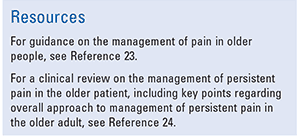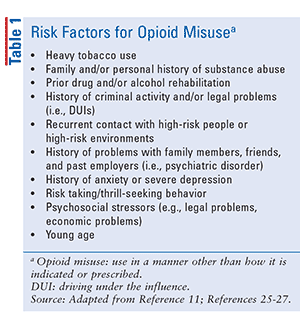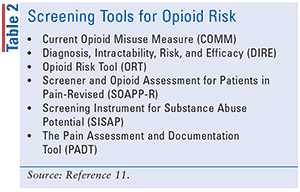US Pharm. 2017:42(12)6-8.
Pancreatitis, or inflammation of the pancreas, may be acute or chronic. It may present as a single attack, recurring episodes, or chronic pain. While acute pancreatitis (AP) and chronic pancreatitis (CP) can be caused by similar etiologies, these conditions usually follow distinct courses. In Western countries, the most common cause of chronic pancreatitis in adults is ethanol abuse.1 Long-term sequelae of CP include dietary malabsorption, impaired glucose tolerance, cholangitis, and potential addiction to opioid analgesics.1 A comprehensive discussion of pancreatitis, both acute and chronic, can be found in Reference 1; the discussion in this article will be limited to specific considerations surrounding the use of opioids and the role of vitamin D supplementation in patients with CP. Pharmacists may find these considerations and recommendations helpful for a nuanced approach to medication management as well as healthcare provider and patient education regarding this condition.
Considerations in Using Opioids for CP Pain
Any complaint of pain should be recognized as a significant problem if it affects physical function or quality of life. The etiology of chronic pain is complex, and treatment usually requires both a pharmacologic and a nonpharmacologic approach.2,3 Effective management of chronic pain is important, because chronic pain is a leading cause of disability and has high societal costs.4-7
Pain management of CP, including nonopioid analgesics such as acetaminophen and nonsteroidal anti-inflammatory drugs, as well as opioids, is much like that of AP.8,9 It is also important to assess CP patients for neuropathic pain; this may help identify opportunities for the use of interventions (e.g., tricyclic antidepressants, pregabalin) that could decrease the need for opioids on a long-term basis (See Resources).
Although opioid analgesics provide effective treatment for noncancer pain, many physicians have concerns about adverse effects, tolerance, and addiction.10 These considerations are of particular concern in older adults with comorbidities and a heightened risk for drug interactions, especially in light of the current opioid epidemic.
Pharmacists have an opportunity to guide and educate healthcare providers and students about the risk factors for opioid misuse (TABLE 1) and the available screening tools for opioid risk assessment (TABLE 2). According to Jamison and colleagues, although there is no “gold standard” for opioid-misuse risk assessment, several validated measures have been shown to be useful in improving patient compliance with opioids and minimizing aberrant drug-related behavior.10 These measures include controlled substance agreements, regular urine drug screens, and interventions such as motivational counseling.10
Furthermore, pharmacists, as patient advocates, need to be aware of pseudoaddiction, an iatrogenic misinterpretation caused by undertreated pain that is identified by the clinician as inappropriate drug-seeking behavior.11 According to Martin and colleagues, misuse behavior (i.e., using any drug in a manner other than how it is indicated or prescribed) ceases when adequate pain relief is provided. Importantly, they note that pseudoaddiction is not a diagnosis, but rather a description of a clinical interaction. Ongoing pain assessment and appropriately targeted, yet comprehensive, medication therapy management is essential.
Focus on Vitamin D in CP
Vitamin D deficiency has been associated with many health conditions, including chronic pain. Patients with chronic pain may be at increased risk of vitamin D deficiency, particularly if they are obese; are likely to have reduced sun exposure; have low levels of physical activity; eat diets low in vitamin D–rich foods; or have malabsorption issues (e.g., CP).11
Rasmussen and colleagues indicate that the pancreas is a major player in nutrient digestion, and while malnutrition is often discovered in patients with CP, it is frequently neglected.12 In patients with CP, fat-soluble vitamins (A, D, E, and K), vitamin B12, and other micronutrients should be supplemented if serum levels indicate deficiencies.12,13 Although vitamin E deficiency may be seen more often than deficiencies of vitamin A, D, and K, osteopathy (i.e., osteoporosis, osteomalacia, osteopenia) can occur in at least one-quarter of patients with CP.14-16 Disturbance of vitamin D status in CP is common, especially with alcoholic etiology and male sex.13 Of note, fibrotic changes, atrophy, and ductal-related pathology were associated with vitamin D deficiency; researchers have indicated that future studies should explore this in further detail.17
Because of the high incidence of osteopathy reported in CP, Rasmussen and colleagues indicate that—extrapolating from guidelines for comparable malabsorptive diseases—calcium and vitamin D supplementation as well as regular monitoring of bone health should be an integral part of the nutritional management of CP; biochemistry and a dual x-ray absorptiometry (DEXA) scan should be performed annually.12 Additional studies are required to evaluate the effects of vitamin D deficiency on bone mineral density among CP patients and the long-term risk of fracture.13
Although CP may lead to a deficiency of fat- soluble vitamins such as vitamin D, little is known of the extent of this in CP.13 Furthermore, sufficient levels of vitamin D are crucial for the absorption of other essential vitamins and minerals, especially calcium, which plays an important role in promoting the health of bone and muscle.18 Vitamin D is also involved in reducing inflammation, modulating cell growth, and influencing the immune and neuromuscular systems.19
Vitamin D and Chronic Pain
A lack of vitamin D has been implicated in chronic pain, as well as a number of other conditions, but whether vitamin D can have beneficial effects in specific chronic, painful conditions needs further investigation.20 It has been suggested that such research should examine whether any beneficial effect is restricted to people who are vitamin D–deficient, in addition to determining the dose and duration required before these effects occur.20 Furthermore, medications commonly used to treat chronic pain and rheumatic conditions, such as anticonvulsants and steroids, can decrease levels of vitamin D; concomitant liver or renal disease may reduce an individual’s ability to metabolize vitamin D.18,21 It has been noted by researchers that although there is no evidence that vitamin D supplementation is an effective treatment for chronic pain, there are no contraindications for its supplemental use among patients with chronic pain; it carries low health risk, is well accepted, and inexpensive.21,22 Therefore, vitamin D should be appropriately recommended when levels are either insufficient or deficient, based on a patient’s additional risk factors (e.g., current medications, obesity level, and exposure to sunlight).
Conclusion
Patients with chronic pain may be at increased risk of vitamin D deficiency, particularly if they have malabsorption issues, both of which are features of chronic pancreatitis. Careful and ongoing pain assessment, appropriate opioid use, and vitamin D supplementation are some of the key elements to be considered in the nuanced pharmacotherapy care plan for patients with chronic pancreatitis.
REFERENCES
1. Then JE, Rouse HM. Pancreatitis. In: Chisholm-Burns MA, Wells BG, Schwinghammer TL, et al, eds. Pharmacotherapy Principles & Practice, 4th ed. New York, NY: McGraw-Hill; 2016:363-370.
2. Cunningham NR, Kashikar-Zuck S. Nonpharmacological treatment of pain in rheumatic diseases and other musculoskeletal pain conditions. Curr Rheumatol Rep. 2013;15:1-8.
3. Uhl RL, Roberts TT, Papaliodis DN, et al. Management of chronic musculoskeletal pain. J Am Acad Orthop Surg. 2014;22:101-110.
4. Vos T, Flaxman AD, Naqhav M, et al. Years lived with disability (YLDs) for 1160 sequelae of 289 diseases and injuries 1990-2010: a systematic analysis for the Global Burden of Disease Study 2010. Lancet. 2012;380:2163-2196.
5. Van Hecke O, Torrance N, Smith BH. Chronic pain epidemiology—where do lifestyle factors fit in? Br J Pain. 2013;7:209-217.
6. Smith BH, Torrance N. Management of chronic pain in primary care. Curr Opin Support Palliat Care. 2011;5:137-142.
7. Rasu RS, Vouthy K, Crowl AN, et al. Cost of pain medication to treat adult patients with non-malignant chronic pain in the United States. J Manag Care Pharm. 2014;20:921-928.
8. Braganza JM, Lee SH, McCloy RF, McMahon MJ. Chronic pancreatitis. Lancet. 2011;377:1184-1197.
9. Puylaert M, Kapural L, Van Zundert J, et al. Pain in chronic pancreatitis. Pain Pract. 2011;11(5):492-505.
10. Jamison RN, Serraillier J, Michna E. Assessment and treatment of abuse risk in opioid prescribing for chronic pain. Pain Res Treat. 2011;2011:941808.
11. Martin KR, Reid DM. Is there a role for vitamin D in the treatment of chronic pain? Ther Adv Musculoskelet Dis. 2017; 9(6):131-135.
12. Rasmussen HH, Irtun O, Olesen SS, et al. Nutrition in chronic pancreatitis. World J Gastroenterol. 2013;19(42):7267-7275.
13. Selby P, Prasad N, Makin A, et al. Determinants of vitamin D deficiency in chronic pancreatitis. Endocrine Abstracts. 2009;19:17.
14. Dujsikova H, Dite P, Tomandl J, et al. Occurrence of metabolic osteopathy in patients with chronic pancreatitis. Pancreatology. 2008;8:583-586.
15. Kalvaria I, Labadarios D, Shephard GS, et al. Biochemical vitamin E deficiency in chronic pancreatitis. Int J Pancreatol. 1986;1:119-128.
16. Nakamura T, Tando Y. [Study on pancreatic steatorrhea in patients with chronic pancreatitis] Nihon Shokakibyo Gakkai Zasshi. 2000;97:1347-1354.
17. Frokjaer J, Olesen SS, Drewes AM. Fibrosis, atrophy and ductal pathology in chronic pancreatitis are associated with pancreatic function but independent of symptoms. Pancreas. 2013:4(7):1182-1187.
18. Holick MF, Binkley NC, Bischoff-Ferrari HA, et al. Evaluation, treatment, and prevention of vitamin D deficiency: an Endocrine Society clinical practice guideline. J Clin Endocrinol Metab. 2011; 96:1911-1930.
19. Institute of Medicine, Food and Nutrition Board. Dietary reference intakes for calcium and vitamin D. Washington, DC: National Academy Press, 2010.
20. Straube S, Derry S, Moore RA, McQuay HJ. Vitamin D for the treatment of chronic painful conditions in adults. Cochrane Database Syst Rev. 2010;(1): CD007771.
21. Straube S, Derry S, Moore RA. Vitamin D for the treatment of chronic painful conditions in adults. Cochrane Database Syst Rev 2015;5:CD007771.
22. Kragstrup TW. Vitamin D supplementation for patients with chronic pain. Scand J Primary Health Care. 2011;29:4-5.
23. Abdulla A, Adams N, Bone M, et al. British Geriatric Society. Guidance on the management of pain in older people. Age Ageing. 2013;42(suppl 1):i1-57.
24. Makris UE, Abrams RC, Gurland B, et al. Management of persistent pain in the older patient a clinical review. JAMA. 2014;312(8):825-836.
25. Gilman SE, Trinh N, Smoller JW, et al. Psychosocial stressors and the prognosis of major depression: a test of Axis IV. Psychol Med. 2013;43(2):303-316.
26. Li RM. Opioids. In: Whalen K, Finkel R, Panavelil TA, eds. Pharmacology, 6th ed. Philadelphia, PA: Wolters Kluwer; 2015:191-204.
27. Motycka C, Spillane J. Drugs of abuse. In: Whalen K, Finkel R, Panavelil TA, eds. Pharmacology, 6th ed. Philadelphia, PA: Wolters Kluwer; 2015:205-213.
To comment on this article, contact rdavidson@uspharmacist.com.








